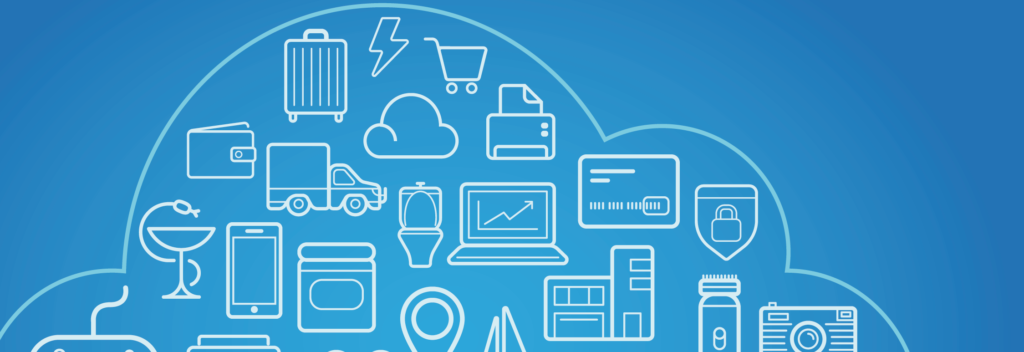As part of the first wave, IoT has been used increasingly within industries. In the second and third wave, IoT, in conjunction with the rise of the fifth generation of the internet, will enhance business even more. This article focusses on what effects IoT has on businesses and how IoT can be used as an important factor to make companies thrive.
Introduction
When Henry Ford invented the assembly line back in the 19th century to produce automobiles more efficiently, he had no clue that he was part of a major shift in history: the second industrial revolution. Today, we are also on the verge of a new major shift in the industry. The so-called ‘Industry 4.0’ is on the rise and its features will be revolutionary. Industry 4.0 will, unlike its predecessors, not be driven by steam or electricity, but by connectivity and communication over the internet.
The driving force behind this development is the Internet of Things (IoT, or in its industrial form, IIoT, Industry Internet of Things). This development entails the fact that internet is not merely used by humans, but that devices and machines are directly connected to the internet, and independently operate and execute smart tasks. In consumer goods one might think of light bulbs that can change color or brightness with the use of your smartphone, or smart refrigerators or weight scales. But, not only in consumer goods are the possibilities endless, also in corporate environments IoT poses lots of new opportunities, or – if not adequately addressed – threats.
But how can companies prepare themselves the best for IoT? What are the current developments, and more importantly, what’s next? Right now, projects focus on connecting assets – machine to machine connection – but IoT has a lot more for us in stock. What will be the next wave, after we all have implemented predictive maintenance? And what are critical success factors for an IoT implementation? How does IoT combine with other technologies, and what are the strategical trade-offs that need to be made?
This article researches the endless possibilities IoT has to offer. It looks at the long- and short-term future, and describes how IoT changes business models, or can deliver new value streams. We do this by taking a close look at one of the industry’s pioneers: Microsoft. Their vision and strategy, accompanied by best practices from their leading cloud platform, gives a clear overview of what is to be expected from IoT in the future.
The first wave of IoT
The developments of IoT can be chronologically ordered in three waves ([Akas19]). Right now, the first wave is hitting the industry landscape, also referred to as the fourth industrial revolution – Industry 4.0 – and its features can be considered as the first round of advantages IoT offers: connecting machines, and putting all kinds of sensors in all kinds of machines. But this fourth industrial revolution does not stand IoT alone; in its wake it attracts all kinds of state-of-the-art innovations, ranging from communication to artificial intelligence. A driving force behind Industry 4.0 is a resilient and fast communication network. Internet is widely available in most countries, but the mobility and speed of the fifth generation of mobile internet (5G), is really going to rock the boat when it comes to IoT. 5G not only offers an enhanced consumer experience and unprecedented mobile, networking capabilities – 5G can power connectivity for a million IoT devices in a half-mile radius – but also enables the management of devices and the collection of data in near real time for analysis and optimization ([Akpa17]).
IoT and fifth generation internet
5G internet is supposed to make way for the rise of Internet of Things, and ensure that the first wave arrives successfully, opening opportunities for the second and third wave. Where previous generations of mobile cellular internet were lacking the necessities in terms of capacity, resilience and speed, 5G is supposed to accommodate the overwhelming ubiquity of sensors used in smart devices and factory machines in a fast way ([Ahok16]). The previous generation, 4G, which has been active since around 2012, has already shown what the Internet of Things could potentiate, but its disadvantages – limited capacity and signal interference – were too many for IoT to thrive.
With speeds of over (theoretical) 10 Gbs per second, and latency of under 1ms, 5G allows us to enter a new era ([Phel20]). This upgrade in speed allows to stream live video at high resolution, which could be used for real time, augmented reality video calling. The ultra-low latency can create safe and robust networks, which could be used for self-driving cars. And the capacity increase allows us to put sensors in all our devices, so that Industry 4.0 can thrive.
Looking at the advantages of IoT and 5G, three main sectors can be distilled that will be boosted by 5G IoT: healthcare, transport and manufacturing. Where in the first two, the use cases might be able to spark one’s imagination already – think of tele-surgery and self-driving cars – the latter might be less known to a wider audience, but nevertheless could entail the greatest impact ([Pala16]).
In manufacturing, we see that current 4G thinking typically creates a linear process: materials are ordered, machines are pre-set and managed by people, and they are maintained by lifetime, not wear and tear. The result? A high potential for costly breakdowns and waste as well as a process that cannot easily respond to changes in demand.
Deploying 5G into this kind of environment can support a business transformation enabling dynamic, self-regulating, and self-adjusting processes that translate into agility, speed, and higher productivity. These benefits will be passed onto the end customer in the form of customization, quality, and speed of delivery. The linear process becomes circular and significant value is created.
5G in combination with IoT sensor equipped factory machines could drastically reshape the current manufacturing process. The level of production detail will increase, and reporting will be more meticulous. This increased monitoring and tracking of products allows, for example, customization of items, on a mass manufacturing scale. Combine this with 3D-printing technologies, and companies get Additive Manufacturing ([Paol17]). Imagine buying mass manufactured sports shoes, where companies could customize several parts online on their demand. Economies of scale are maintained, so the price can remain low, and smart machinery tracks your individual order through the process, making sure customized materials and 3D-printed parts are ready exactly when needed.
The future waves of IoT
So, the first wave of IoT benefits is clear. Machines are connected, delivering data streams which lead to smart manufacturing, and predictive maintenance will be the standard. But what do the future IoT applications have in stock for us? For this, we have to look at the big players in the market. And big players set themselves apart with big investments.
The IoT market is expected to hit $1,102 billion by 2026 ([Fort20]). Continuously, companies invest massive amounts in this new technology, and this sets the leaders apart from the laggards ([Chui19]). Microsoft, who recently invested $5 billion into IoT development ([Barr18]), can be considered as leading in the IoT business ([Leon17]). It accompanies this huge investment with a leading cloud platform (Azure), which is also recognized by Gartner, in its magic quadrant for cloud infrastructure as a service (Figure 1).
Figure 1. Magic Quadrant for Cloud Infrastructure as a Service ([Dign19]). [Click on the image for a larger image]
Microsoft shares a vision when it comes to the evolution of connected IoT solutions. Right now, they see the current trend of connecting various assets: the first wave ([Duga20]). IoT is currently being used to make a machine-to-machine connection: a production machine gives notice when it needs maintenance, or a made a production error.
In the near future, the trend is moving more to connecting environments, the second wave. In this emerging trend the focus lies more on connecting the environments in which the assets operate. By means of establishing digital feedback loops, supply chains can be connected through participating companies, and smart manufacturing can flourish. This leads to interoperability between different companies, either before or after each other in the supply chain, but also to supportive organizations, such as transporting services or governmental bodies.
In the longer term, this trend leads to embedded connected ecosystems, the third wave. The most stunning example is a Smart City: a large living society in which all is connected and everyone interacts. In a connected ecosystem, private and public sectors are also connected. That means that the integrated value chain of companies is linked to the smart city it is part of. It can minimize traffic congestion in the city, or have a real-time adjustment in public transport services, based on the employees currently in office.
Future waves: how and what?
Based on Microsoft’s view, as explained before, we are converging to an all-connected ecosystem approach. After the first wave of connecting assets with IoT sensors, we see that IoT has the capability to create new value streams and disrupt current business models. Especially when IoT is combined with other techniques, such as machine learning, artificial intelligence or virtual reality, the new use cases rise significantly. Table 1 gives a short explanation for each domain, with real life examples, all running on the Azure platform.
Table 1. How IoT affects various domains ([Akas19]). [Click on the image for a larger image]
But there is more to it. Implementing IoT is more than just the technology. A holistic approach is necessary to harness the complete benefit package that IoT can offer. Of course, the technology is essential, but other critical success factors should not be missed. The key enablers are: forming partnerships with other players, critically looking at core business processes, form a decent business strategy, and have leadership involved (Table 2).
In the corresponding research that was reporting these results ([Akas19]), two third of the respondents indicated that having a decent business strategy was the most important factor. Also, the biggest challenge to overcome was the resistance to changing the existing business models and processes. As IoT has disruptive elements, and can optimize the complete way of working, it is key to let it in to the core of your company and allow the projects to critically look at vital processes.
If you don’t peel back the company enough to reach the core, you might end up in optimistically connecting all machines and devices, without fully thinking through the consequences and objectives. IoT is a solution, but it is vital to start defining and capturing the problem first. Only then, together with partnerships and competent leadership, are the true possibilities of IoT unraveled.
Table 2. Success factors for IoT ([Akas19]). [Click on the image for a larger image]
Microsoft’s architectural response
Microsoft acts as a leader and visionary in this spectrum on the strategical side, but also offers technical highly capable solutions of connecting, managing and leveraging IoT devices ([Leon17]). Microsoft is constantly developing and updating its portfolio to accommodate the vastly changing possibilities. They have developed several SaaS and PaaS solutions, such as Azure IoT Central, IoT Reference Architecture & Accelerators and Dynamics connected field service, also for future Edge Computing network, Azure offers support. Recently, the new Azure RTOS and Sphere have gone live, as well as IoT Edge and Stack Edge, for accommodating the future needs in Edge computing.
To understand the capabilities of Azure, and the way it adds value to IoT projects, it is good to understand the layered approach Azure offers. The bottom layer acts as a supporting layer. It is the place where all connections are made. Here we find applications such as Sphere and Device SDK.
The second layer offers a rich PaaS portfolio, which can be used to combine solutions and let them communicate with all the other Azure functionalities. This is the layer where the IoT devices’ output is coupled to applications which do the further processing. From this layer, the insights emerge, and the real power of Azure reveals itself. The main application here is the IoT Hub, which is the linchpin between other services, such as Azure Artificial Intelligence, Cognitive Services, DevOps, Digital Twins and PowerBI (and many, many more).
In the third and top layer, you will find offerings in the solutions phase; this is what sets Microsoft apart from the competition. Here you will find Azure IoT Central and Dynamics Connected Field Service, both SaaS solutions, which can be combined with reference architecture and open source accelerators.
This layered approach makes it simpler. In order to fully understand it, we can use the following analogy: “From a business perspective, we can use the terms: things, insights and actions”, says Aditi Dugar, a senior program manager in Azure IoT central. “Things can be seen as devices, the basic layer. The insights come from the second layer, where a connection is made with other Azure services. Lastly, and most importantly, there are actions; all the possible things you can undertake. Actions come from the top layer and can be visualized in applications, turning the IoT solution into a true business integration.”
Figure 2. A typical IoT solution, from Microsoft’s viewpoint ([Micr20]). [Click on the image for a larger image]
Client Case
Based on this layered implementation technique, some innovative solutions have already been realized. In London, for example, they found an innovative use of Microsoft’s IoT Hub. They use it for keeping their vertical gardens beautiful and green. In a city with almost 9 million inhabitants, nature is sometimes hard to find. As a solution, several buildings have been decorated with vertical gardens: long streaks of green plants and flowers growing vertically against a building or wall. This gives a “green feeling” and diminishes the effect of a concrete jungle.
But growing plants in a city is a complex undertaking: nourishing thousands of plants, which all need a steady supply of water and nutrition in the exact amounts that serves their individual needs. Too much water and the plants start to grow too fast, too little water and they dry out. Although all the irrigation systems are automated, a clogged-up system leads to malfunctions. In that case, the plants dry out, but even worse, leaking irrigation systems causes water seepage into the floors of expensive London apartments – a very unpleasant but unavoidable situation, even with regular maintenance intervals.
The goal was to intervene in the event of an issue, before inhabitants noticed the problem, or, before the plants were severely damaged. Together with Microsoft, and a third party IoT sensor supplier, they incorporated the internet of things in the vertical gardens. This way they could measure the water levels in real time, and act on system malfunctions. With the use of Azure’s IoT Hub, it was possible to create a dashboard for each of the “living wall”, showing its current health, and the status for each of the plants. Because Microsoft’s IoT Hub supports myriad different devices, from various suppliers, setting up the system took no effort.
Not only does such an application reduce maintenance cost and improve the brand reputation of the “living walls”, it also gives a strategical advantage over the competition. With the use of IoT they can cut down on maintenance and plant replacement cost. Also, the delivered product looks way better, which contributes to the brand perception. In the long run, this even leads to lower costs of the living walls, which might make living in London just a little cheaper.
Conclusion
All in all, we haven’t heard the last of IoT yet. It is very promising for the future, but as authors we also invite users to look beyond the first wave. IoT is more than merely connecting machines or letting your fridge check what you can eat tonight, it truly offers possibilities to be disruptive and open doors which would otherwise have remained closed. Also, to discover the true advantages of IoT, it is important to look beyond just technology. Start with a decent and creative strategy and be willing to critically look at core business models and processes. Only with an integral and holistic look will it be possible to benefit from the true distinguishing benefits. The technology needed is already in place and ready for use.
References
[Ahok16] Ahokangas, P., Moqaddamerad, S., Matinmikko, M., Abouzeid, A., Atkova, I., Gomes, J. F., & Iivari, M. (2016). Future micro operators business models in 5G. The Business & Management Review, 7(5), 143.
[Akas19] Akash, B., Yusuf, Z., Misra, N., Andersen, P., Nandi, S., Subramania, J., & Bhat, N. (April, 2019). Beyond Predictive Maintenance – The ‘art of the possible’ with IoT. Boston Consulting Group / Microsoft.
[Akpa17] Akpakwu, G. A., Silva, B. J., Hancke, G. P., & Abu-Mahfouz, A. M. (2017). A survey on 5G networks for the Internet of Things: Communication technologies and challenges. IEEE access, 6, 3619-3647.
[Barr18] Barret, S. (2018, April 9). Microsoft invests $5 billion in IoT. Retrieved from: https://www.anegis.com/articles/ms-invests-5bn-in-iot
[Chui19] Chui, M., May, B. Narayanan, S. & Shah, R. (2019, January 7). What separates leaders from laggards in the Internet of Things. McKinsey Digital. Retrieved from: https://www.mckinsey.com/business-functions/mckinsey-digital/our-insights/what-separates-leaders-from-laggards-in-the-internet-of-things.
[Dign19] Dignan, L. (2019, July 18). Between the Lines. Retrieved from: https://www.zdnet.com/article/google-cloud-gains-in-gartners-2019-cloud-infrastructure-magic-quadrant/
[Duga20] Dugar, A. (2020, January 14). Get Beyond POC – Build your custom IoT Solution with Azure IoT Central. Retrieved from: https://www.youtube.com/watch?v=WfG2vUhYt7U
[Fort20] Fortune Business Insights (2020, June 15). Internet of Things (IoT) Market to Hit $1,102.6 Billion by 2026; Advancements in Artificial Intelligence-based Technologies to Feed Market Growth: Fortune Business Insights™. Retrieved from: https://www.globenewswire.com/news-release/2020/06/15/2047963/0/en/Internet-of-Things-IoT-Market-to-Hit-1-102-6-Billion-by-2026-Advancements-in-Artificial-Intelligence-based-Technologies-to-Feed-Market-Growth-Fortune-Business-Insights.html
[Geor20] George, S. (2020, June 4). Microsoft IoT Vision and Roadmap. Retrieved from: https://channel9.msdn.com/Events/Build/2020/INT176
[Leon17] Leong, L., Bala, R., Lowery, C. & Smith, D. (2017). Gartner Magic Quadrant for Cloud Infrastructure as a Service.
[Micr19] Microsoft (2019, May 3). Sagegreenlife keeps living walls green with an easy-to-use IoT solution. Retrieved from: https://customers.microsoft.com/en-us/story/sagegreenlife-smart-spaces-azure-cradlepoint
[Micr20] Microsoft (2020, August 8). Wat is Azure IoT Hub? Retrieved from: https://docs.microsoft.com/nl-nl/azure/iot-hub/about-iot-hub
[Pala16] Palattella, M. R., Dohler, M., Grieco, A., Rizzo, G., Torsner, J., Engel, T., & Ladid, L. (2016). Internet of things in the 5G era: Enablers, architecture, and business models. IEEE Journal on Selected Areas in Communications, 34(3), 510-527.
[Paol17] Paoletti, I. (2017). Mass customization with additive manufacturing: new perspectives for multi performative building components in architecture. Procedia Engineering 180, 1150-1159.
[Phel20] Phelan, D. (2020, May 28). 5G: These Are The Fastest And Most Widely-Available 5G Networks. Forbes. Retrieved from: https://www.forbes.com/sites/davidphelan/2020/05/28/5g-these-are-the-fastest-and-most-widely-available-5g-networks/#17e98a661c29
[Shaw13] Shaw, K. (2013, November 13). What is edge computing and why it matters. Network World. Retrieved from: https://www.networkworld.com/article/3224893/what-is-edge-computing-and-how-it-s-changing-the-network.html.
[Shop20] Shoplogix (2020, February 7). 5 Examples of Industrial IoT in Action. Retrieved from: https://shoplogix.com/blog/5-examples-industrial-iot-action/










